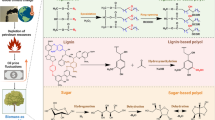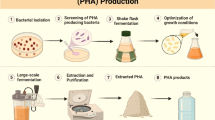Abstract
In order to solve the problem of low molecular weight in the synthesis of poly(ethylene 2,5-furandicarboxylate) (PEF) copolyester with titanium-based catalysts, this paper introduce an appropriate amount of glycerol (GC) into PEF to branch the straight chain polyester though the transesterification-melt polycondensation method, which solve the problem of low resin viscosity and low molecular weight. The structures of the copolymers were characterized by 1H-NMR and 13C-NMR, and the results showed that the modified PEF copolyesters and poly(ethylene-co-glycerol 2,5-furandicarboxylate) (PEGFs) were successfully prepared. The intrinsic viscosity ([η]) of PEGFs copolyesters was characterized by Ubbelohde viscosity, and the results showed that the copolyester [η] was increased from 0.25 dL/g to 0.755 dL/g. The thermal properties of copolyester were characterized by differential scanning calorimetry and thermo gravimetry, and it was found that the glass transition temperature of PEGFs copolyester increased from 67.8 °C to 89.5 °C, and the maximum pyrolysis rate temperature increased from 386.6 °C to 402.8 °C. We characterized the UV resistance of PEGFs copolyester, and the results showed that PEGFs copolyester could be well degraded under ultraviolet light.
Graphical abstract














Similar content being viewed by others
References
R. Singh, B.B. Krishna, J. Kumar, T. Bhaskar, Opportunities for utilization of non-conventional energy sources for biomass pretreatment. Bioresource Technol. 199, 398–407 (2016). https://doi.org/10.1016/j.biortech.2015.08.117
H. Kobayashi, A. Fukuoka, Development of Solid Catalyst-Solid Substrate Reactions for Efficient Utilization of Biomass. B. Chem. Soc. Jpn. 91, 29–43 (2018). https://doi.org/10.1246/bcsj.20170263
K. Vavrova, J. Knapek, J. Weger, Short-term boosting of biomass energy sources-Determination of biomass potential for prevention of regional crisis situations. Renew. Sust. Energ. Rev. 67, 426–436 (2017). https://doi.org/10.1016/j.rser.2016.09.015
M. Sajid, X.B. Zhao, D.H. Liu, Production of 2, 5-furandicarboxylic acid (FDCA) from 5-hydroxymethylfurfural (HMF): recent progress focusing on the chemical-catalytic routes. Green Chem. 20, 5427–5453 (2018). https://doi.org/10.1039/C8GC02680G
J. Deng, H.J. Song, M.S. Cui, Y.P. Du, Y. Fu, Aerobic Oxidation of Hydroxymethylfurfural and furfural by using heterogeneous CoxOy-N@C catalysts. Chemsuschem 29, 3334–3340 (2014). https://doi.org/10.1002/cssc.201402843
A.F. Sousa, M. Matos, C.S.R. Freire, A.J.D. Silvestre, J.F.J. Coelho, New copolyesters derived from terephthalic and 2,5-furandicarboxylic acids: a step forward in the development of biobased polyesters. Polymer 54, 513–519 (2013). https://doi.org/10.1016/j.polymer.2012.11.081
M. Matos, A.F. Sousa, N.H.C.S. Silva, C.S.R. Freire, M. Andrade, A. Mendes, A.J.D. Silvestre, Furanoate-based nanocomposites: a case study using poly (Butylene 2, 5-Furanoate) and Poly (Butylene 2, 5-Furanoate)-co-(Butylene Diglycolate) and bacterial cellulose. Polymers 10, 810–826 (2018). https://doi.org/10.3390/polym10080810
Y. Jiang, A.J.J. Woortman, G.O.R.A. van Ekenstein, K. Loos, A biocatalytic approach towards sustainable furanic-aliphatic polyesters. Polym. Chem. 6, 5198–5211 (2015). https://doi.org/10.1039/C5PY00629E
G.Z. Papageorgiou, D.G. Papageorgiou, Z. Terzopoulou, D.N. Bikiaris, Production of bio-based 2,5-furan dicarboxylate polyesters: Recent progress and critical aspects in their synthesis and thermal properties. Eur. Polym. J. 83, 202–229 (2016). https://doi.org/10.1016/j.eurpolymj.2016.08.004
S. Thiyagarajan, W. Vogelzang, R.J.I. Knoop, A.E. Frissen, J. van Haveren, D.S. van Es, Biobased furandicarboxylic acids (FDCAs): effects of isomeric substitution on polyester synthesis and properties. Green Chem. 16, 1957–1966 (2014). https://doi.org/10.1039/C3GC42184H
Z.H. Zhang, K.J. Deng, Recent Advances in the catalytic synthesis of 2, 5-furandicarboxylic acid and its derivatives. ACS Catal. 11, 6529–6544 (2015). https://doi.org/10.1021/acscatal.5b01491
L. Papadopoulos, A. Zamboulis, N. Kasmi, M. Wahbi, C. Nannou, D.A. Lambropoulou, M. Kostoglou, G.Z. Papageorgiou, D.N. Bikiaris, Investigation of the catalytic activity and reaction kinetic modeling of two antimony catalysts in the synthesis of poly (ethylene furanoate). Green Chem. 23, 2507–2524 (2021). https://doi.org/10.1039/D0GC04254D
G.Z. Papageorgiou, V. Tsanaktsis, D.N. Bikiaris, Synthesis of poly (ethylene furandicarboxylate) polyester using monomers derived from renewable resources: thermal behavior comparison with PET and PEN. Phys. Chem. Chem. Phys. 16, 7946–7958 (2014). https://doi.org/10.1039/C4CP00518J
L. Papadopoulos, A. Magaziotis, M. Nerantzaki, Z. Terzopoulou, G.Z. Papageorgiou, D.N. Bikiaris, Synthesis and characterization of novel poly (ethylene furanoate-co-adipate) random copolyesters with enhanced biodegradability. Polym. Degrad. Stabil. 156, 32–42 (2018). https://doi.org/10.1016/j.polymdegradstab.2018.08.002
X.L. Qu, G.Y. Zhou, R. Wang, H.Y. Zhang, Z.P. Wang, M. Jiang, J. Tang, Insights into high molecular weight poly (ethylene 2, 5-furandicarboxylate) with satisfactory appearance: Roles of in-situ catalysis of metal zinc. J. Ind. Eng. Chem. 99, 422–430 (2021). https://doi.org/10.1016/j.jiec.2021.04.052
Z. Terzopoulou, E. Karakatsianopoulou, N. Kasmi, M. Majdoub, G.Z. Papageorgiou, D.N. Bikiaris, Effect of catalyst type on recyclability and decomposition mechanism of poly (ethylene furanoate) biobased polyester. J. Anal. Appl. Pyrol. 126, 357–370 (2017). https://doi.org/10.1016/j.jaap.2017.05.010
J.G. Wang, X.Q. Liu, Y.J. Zhang, F. Liu, J. Zhu, Modification of poly (ethylene 2, 5-furandicarboxylate) with 1, 4-cyclohexanedimethylene: Influence of composition on mechanical and barrier properties. Polymer 103, 1–8 (2016). https://doi.org/10.1016/j.polymer.2016.09.030
Y. Chebbi, N. Kasmi, M. Majdoub, G.Z. Papageorgiou, D.S. Achilias, D.N. Bikiaris, Solid-State Polymerization of Poly (Ethylene Furanoate) Biobased Polyester, III: Extended Study on Effect of Catalyst Type on Molecular Weight Increase. Polymers 11, 438–463 (2019). https://doi.org/10.3390/polym11030438
S. Gu, M. Yang, T. Yu, T. Ren, J. Ren, Synthesis and characterization of biodegradable lactic acid-based polymers by chain extension. Polym. Int. 57, 982–986 (2010). https://doi.org/10.1002/pi.2435
H.H. Yang, J. He, B.R. Liang, Transesterification kinetics of poly (ethylene terephthalate) and poly (ethylene 2, 6-naphthalate) blends with the addition of 2, 2′-bis (1, 3-oxazoline). J. Polym. Sci. B Polym. Phys. 39, 2607–2614 (2010). https://doi.org/10.1002/polb.10021
Q.Y. Zhu, Y.S. He, J.B. Zeng, Q. Huang, Y.Z. Wang, Synthesis and characterization of a novel multiblock copolyester containing poly (ethylene succinate) and poly (butylene succinate) Mater. Chem. Phys. 130, 943–949 (2011). https://doi.org/10.1016/j.matchemphys.2011.08.012
A.A. Haralabakopoulos, D. Tsiourvas, C.M. Paleos, Chain extension of poly (ethylene terephthalate) by reactive blending using diepoxides. J. Appl. Polym. Sci. 71, 2121–2127 (1999). https://doi.org/10.1002/(SICI)1097-4628(19990328)71:13%3c2121::AID-APP1%3e3.0.CO;2-Y
J.N.B. Zhao, X.F. Wu, W.T. Yang, Synthesis of aliphatic polyesters by a chain-extending reaction with octamethylcyclotetrasilazane and hexaphenylcyclotrisilazane as chain extenders. J. Appl. Polym. Sci. 92, 3333–3337 (2010). https://doi.org/10.1002/app.20330
A. Takasu, A. Takemoto, T. Hirabayashi, Polycondensation of dicarboxylic acids and diols in water catalyzed by surfactant-combined catalysts and successive chain extension. Biomacromol 7, 16–29 (2006). https://doi.org/10.1021/bm050485p
W.F. Fan, Y. Zhao, A.J. Zhang, Y.X. Cao, J.Z. Chen, Effect of a chain extender on the properties of poly(lactic acid)/zinc oxide/copper chlorophyll acid antibacterial nanocomposites. J. Appl. Polym. Sci. 132, 41–61 (2015). https://doi.org/10.1002/app.41561
B.H. Bimestre, C. Saron, Chain extension of poly (ethylene terephthalate) by reactive extrusion with secondary stabilizer. Mat. Res. 15, 467–472 (2012). https://doi.org/10.1590/S1516-14392012005000058
R. Singh, B.B. Krishna, J. Kumar, T. Bhaskar, Opportunities for utilization of non-conventional energy sources for biomass pretreatment. Bioresour. 199, 398–407 (2016). https://doi.org/10.1016/j.biortech.2015.08.117
C. Chatterjee, F. Pong, A. Sen, Chemical conversion pathways for carbohydrates. Green Chem. 17, 40–71 (2014). https://doi.org/10.1039/C4GC01062K
J.P. Wu, H.Z. Xie, L.B. Wu, B.G. Li, P. Duboi, DBU-catalyzed biobased poly (ethylene 2, 5-furandicarboxylate) polyester with rapid melt crystallization: synthesis, crystallization kinetics and melting behavior. Rsc Adv. 6, 13877–13887 (2016). https://doi.org/10.1039/C6RA21135F
G.Z. Papageorgiou, V. Tsanaktsis, D.N. Bikiaris, Synthesis of poly(ethylene furandicarboxylate) polyester using monomers derived from renewable resources: Thermal behavior comparison with PET and PEN. Phys. Chem. Chem. Phys. 16, 7946–7951 (2014). https://doi.org/10.1039/C4CP00518J
K.H. Hsu, C.W. Chen, L.Y. Wang, H.W. Chan, C.L. He, C.J. Cho, S.P. Rwei, C.C. Kuo, Bio-based Thermoplastic Poly (Butylene Succinate-co-Propylene Succinate) Copolyesters: Effect of Glycerol on Thermal and Mechanical Properties. Soft Matter 15, 9710–9720 (2019). https://doi.org/10.1039/C9SM01958H
Acknowledgements
The author would like to thank the National Natural Science Foundation of China (Nos. 21878231), Tianjin Natural Science Foundation of China (19JCZDJC37300) and the China National Textile and Apparel Council (J201406) for their financial supports. We would like to thank the Analytical & Testing Center of Tiangong University for differential scanning calorimetry work.
Author information
Authors and Affiliations
Contributions
Chengzhi Liu: investigation, experiments and data processing, writing—original draft. Dongsheng Zhao: data curation, writing—review and editing. Maliang Zhang: conceptualization, investigation. Kunmei Su: writing—review and editing, resources, supervision. Zhenhuan Li: project administration, writing—review and editing, resources.
Corresponding authors
Ethics declarations
Conflict of interest
The authors declare that they have no known competing financial interests or personal relationships that could have appeared to influence the work reported in this paper.
Additional information
Publisher's Note
Springer Nature remains neutral with regard to jurisdictional claims in published maps and institutional affiliations.
Rights and permissions
Springer Nature or its licensor (e.g. a society or other partner) holds exclusive rights to this article under a publishing agreement with the author(s) or other rightsholder(s); author self-archiving of the accepted manuscript version of this article is solely governed by the terms of such publishing agreement and applicable law.
About this article
Cite this article
Liu, C., Zhao, D., Zhang, M. et al. Modification of biomass furan-based PEF copolyester with glycerol. Macromol. Res. 32, 59–70 (2024). https://doi.org/10.1007/s13233-023-00208-8
Received:
Revised:
Accepted:
Published:
Issue Date:
DOI: https://doi.org/10.1007/s13233-023-00208-8




